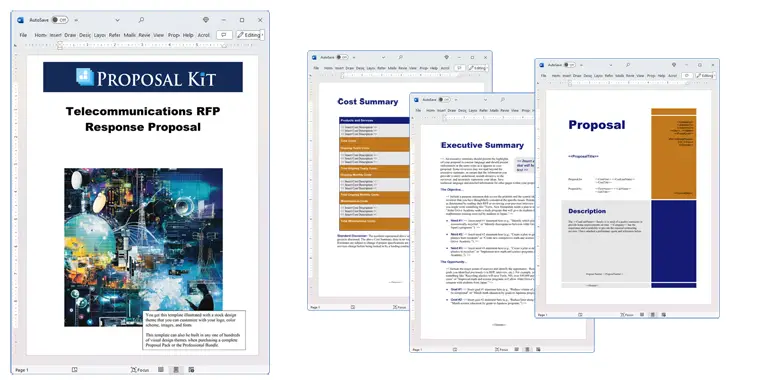How to write your Telecommunications RFP Response Proposal
We include this 23 page layout with every Proposal Pack. If you want this template to have a different visual design theme than the one illustrated here, purchase any Proposal Pack design and create this template using the purchased design theme. This template is included in every Proposal Pack. If you get a Proposal Pack or the Professional, you can also make any variation of this template with different chapters to suit your needs.
We typically include more chapters in the templates than most people will need to give everyone more variety in the chapters they may need. You can trim down a long template by removing pages you do not need or combining multiple chapter topics into one page.
 DOWNLOADABLE, ONE-TIME COST, NO SUBSCRIPTION FEES
DOWNLOADABLE, ONE-TIME COST, NO SUBSCRIPTION FEESYou can also create countless variations of this document to suit your needs using the included library of 2200+ chapters if ordering a Proposal Pack or Professional.
 What Our Clients Say
What Our Clients SayGot a large deal with my first proposal using your system. Love it!"
Related Article
Related Video
Related Templates
- Telecommunications Cellular Services Proposal
- Broadband Services Provider Proposal
- IT Product and Service Sales Proposal
- Internet Service Provider (ISP) Proposal
- Equipment or Machinery Systems Upgrade Proposal
- Software and Hardware System Proposal
- IT Equipment Maintenance and Repair Services Proposal
- Geospatial Intelligence Department Setup Proposal
- Software Automation Proposal
What's the best way to write your telecommunications RFP response proposal?
Using Proposal Kit's software and template library is a proven solution for writing a telecom proposal. Proposal Kit not only offers customizable templates but also includes a line item quoting database system to streamline cost summaries, quotes, estimates, budgets, and other financial topics. This comprehensive tool ensures you cover all necessary topics and efficiently.
Do you need to write a telecom proposal to win a contract or project? The Proposal Kit is designed for you. It provides the necessary tools to create a professional and persuasive proposal that meets all RFP requirements.
What Types of Projects Are Telecommunications RFP Response Proposal Written For?
Telecommunications proposals are written for a variety of projects. These proposals are vital in securing contracts for diverse telecommunications projects, such as:
- Implementing a new VoIP system for a corporation
- Designing a secure network infrastructure
- Upgrading a company's telecommunications hardware
- Providing managed IT services
- Launching a cloud-based communication platform
- Conducting a network audit and assessment
- Offering cybersecurity solutions
- Setting up a video conferencing system
- Installing a wireless communication network
- Developing a mobile application for communication
- Enhancing customer support systems
- Providing telecom consulting services
- Creating a disaster recovery communication plan
- Implementing a unified communication system
- Expanding broadband internet services
- Facilitating remote work solutions
- Deploying a call center solution
- Designing an IoT communication network
- Offering data center migration services
- Establishing a satellite communication link
Chapters this template is built with
There is no one-size-fits-all premade template that works for all telecom proposals. This is why the Proposal Kit allows you to create custom variations of proposals that address all potential situations using its document assembly software and template library. The following components are examples of chapters that can be tailored using Proposal Kit's extensive library of thousands of templates:
Cover Letter
In a telecommunications proposal, the Cover Letter serves as your introduction to the potential client. It should clearly articulate your understanding of their needs and how your solutions address these requirements. Highlighting your unique selling points and establishing a connection with the reader right at the outset can set a positive tone for the rest of the proposal.
Introduction
The Introduction section should provide a concise overview of your company, its mission in the telecommunications industry, and the objective of your proposal. This is your chance to establish your credibility by mentioning any relevant experience or past successes that align with the client's needs, thereby setting a strong foundation for the detailed content that follows.
Executive Summary
In the Executive Summary, summarize the key topics of your telecommunications solution, emphasizing the benefits and how they specifically address the RFP requirements. This section should distill the essence of your proposal into a narrative that grabs the decision-makers attention and encourages them to read further.
Cost Summary
The Cost Summary is crucial in a telecommunications proposal as it delineates the financial investment required from the client. Using Proposal Kit's quoting database system, you can break down costs into clear line items, such as equipment, services, and support, providing clarity and helping the client understand the value they are receiving.
Scope
The Scope section should clearly define the parameters of the telecommunications project, specifying what is included and what is excluded. This is particularly important in avoiding scope creep and ensuring both parties have a mutual understanding of the project's boundaries and deliverables.
Features
In the Features section, detail the technical and functional topics of your telecommunications solution. Whether it's advanced networking capabilities or state-of-the-art communication tools, this section should highlight how these features will meet or exceed the client's expectations and requirements outlined in the RFP.
Project Deliverables
Project Deliverables should clearly outline what the client can expect to receive at the conclusion of the project. This includes tangible outcomes such as installed hardware, implemented systems, or completed training sessions. Clear deliverables help set client expectations and provide a basis for evaluating the project's success.
Deadlines
The Deadlines section should provide a realistic timeline for project milestones and completion. This section is critical for managing client expectations and demonstrating your ability to deliver the telecommunications project in a timely manner, potentially offering a competitive advantage over others.
Maintenance
In the Maintenance section, outline the post-implementation support and maintenance services you offer. This could include software updates, hardware servicing, and ongoing customer support. Highlighting your commitment to long-term client satisfaction can reassure the client of your dedication to the project's success beyond its initial completion.
Project Background
The Project Background provides context to your proposal by explaining the need for the project. Discuss the current challenges faced by the client and how your telecommunications solution aims to resolve these issues. This section helps the client see the bigger picture and the urgency or importance of the proposed project.
Installation Schedule
The Installation Schedule should offer a detailed plan for the deployment of your telecommunications solution. This includes the sequence of events, anticipated timeline, and resource allocation. Providing this information upfront helps the client understand the logistical topics and ensures alignment on the project timeline.
Hardware and Software
The Hardware and Software section should enumerate the technological components necessary for the project. By specifying what equipment and software are required, you provide transparency to the client and help them prepare for the integration of your solution within their existing infrastructure.
Customer Support
In the Customer Support section, discuss the support services available to the client, such as a dedicated help desk, onsite assistance, or remote troubleshooting. Emphasize your commitment to ensuring the client's telecommunications systems function smoothly and efficiently post-implementation.
Performance Requirements
The Performance Requirements section should specify the performance standards your solution will meet, such as network uptime, speed, and security measures. Clearly stating these requirements assures the client that your proposal aligns with their operational standards and expectations.
Cost/Benefit Analysis
A Cost/Benefit Analysis helps the client understand the financial implications of your proposal, weighing the costs against the anticipated benefits. Use this section to highlight the return on investment and long-term savings your telecommunications solution offers, making a case for its adoption.
Qualifications
The Qualifications section should highlight your company's expertise and experience in handling similar telecommunications projects. Include any relevant certifications, partnerships, or notable projects that showcase your capability to deliver high-quality solutions.
Company History
In the Company History section, provide a brief narrative of your company's journey, emphasizing milestones and achievements in the telecommunications sector. This background helps build trust, giving the client confidence in your established presence and reliability in the industry.
Reliability
The Reliability section should focus on the dependability of your services and products. Provide examples or case studies that demonstrate your track record of delivering successful telecommunications projects, reassuring the client of your consistent performance.
References
Include References from previous clients or projects that illustrate your success and expertise. Testimonials or case studies can serve as powerful endorsements, offering external validation of your capabilities and reliability.
Standards Compliance
The Standards Compliance section should detail how your solution adheres to industry standards and regulations. This demonstrates professionalism and assures the client that your proposal meets necessary legal and operational benchmarks, mitigating potential risks.
Use cases for this template
Creating a Winning Proposal for Secure Infrastructure
The Challenge
Emma, a project manager at GlobalConnect Enterprises, faced a challenge. Her company was in a competitive race to secure a contract for launching a secure network infrastructure for a major client. This project was critical for GlobalConnect, not only because of its potential revenue but also for the prestige of working with a high-profile client. Emma knew that the proposal needed to be exceptional, addressing all technical requirements while showcasing the company's expertise.
The Solution
Emma decided to use the Proposal Kit to navigate the complexities of the proposal process. The comprehensive template library offered by Proposal Kit was a game-changer. It provided Emma with a structured format that ensured no important details were overlooked. The variety of templates allowed Emma to select the most relevant sections, creating a proposal that was both detailed and persuasive.
The Implementation
Emma and her team devoted time to customizing the templates to align perfectly with their project goals and the RFP's specifications. They made extensive use of the line item quoting database, which allowed them to present a clear and detailed cost summary. This transparency in financial planning was crucial in convincing the client of the project's feasibility and value.
The Outcome
The result was a professional and compelling proposal that stood out to the client. GlobalConnect Enterprises won the contract, marking a significant victory for Emma and her team. Their well-organized and persuasive proposal, created with the help of the Proposal Kit, demonstrated their capability and secured their position as a leader in network security solutions.
Accelerating Proposal Delivery for Internal Upgrades
The Challenge
Liam, an IT specialist at TechWave Solutions, found himself under pressure. He was tasked with a comprehensive telecom upgrade for the company's internal communication system. With only a short window to deliver the proposal, Liam knew he had to work efficiently without sacrificing quality or detail.
The Solution
Liam turned to the Proposal Kit for assistance. The software's intuitive templates and organizational tools allowed him to quickly assemble a well-structured proposal. To further expedite the process, Liam combined these templates with an AI writing tool, which helped generate content that was both comprehensive and aligned with the company's goals.
The Implementation
By using AI technology, Liam was able to analyze the company's website for existing content that could be repurposed within the proposal. He tailored the templates to fit the project requirements, ensuring that each section addressed the specific needs and expectations of the internal stakeholders. This innovative approach significantly reduced the time required to complete the proposal.
The Outcome
TechWave Solutions was impressed with the proposal Liam delivered. Its clarity and thoroughness communicated the benefits of the telecom upgrade, resulting in swift approval from management. Liam's use of Proposal Kit and AI tools not only met the tight deadline but also ensured the proposal's success.
Strategically Attracting Telecom Providers for Non-Profit Needs
The Challenge
Sophia, a director at CommunityLink, was tasked with an important project - writing an RFP for telecom services that would enhance communication within the non-profit organization. This project was crucial for improving outreach and operational efficiency. Sophia needed to ensure that the RFP was clear and detailed enough to attract the right providers capable of delivering the solutions CommunityLink required.
The Solution
Sophia chose the Proposal Kit to assist her in writing a detailed and professional RFP. The template library offered by Proposal Kit provided her with a solid foundation, helping her articulate the project requirements clearly. The structured approach allowed Sophia to ensure that all necessary information was included, from technical specifications to budgetary constraints.
The Implementation
Sophia customized the templates to reflect CommunityLink's specific needs. She placed significant emphasis on highlighting performance requirements and standards compliance, which are key factors in attracting reliable vendors. This careful preparation ensured that the RFP was not only comprehensive but also competitive, making it more appealing to potential providers.
The Outcome
CommunityLink received numerous proposals from qualified telecom providers, enabling them to select the best solution for their needs. Sophia's thoughtful use of the Proposal Kit was instrumental in creating an effective RFP that communicated the organization's goals and requirements clearly. As a result, CommunityLink was able to enhance its communication infrastructure, significantly boosting its operational capabilities and outreach efforts.
Conclusions and Recommendations
Creating a telecom proposal can be simplified by using Proposal Kit. Whether responding to an RFP or writing an internal proposal, the comprehensive template library and software package provide a reliable solution. By customizing templates and using the quoting database, Proposal Kit ensures you address all crucial aspects - from costs to compliance. This approach not only streamlines the proposal process but also increases your chances of success.
Also Known As
This template may also be referred to in different ways or be used in more specialized situations, such as:
- Telecom Proposal Response
- Telecommunications Bid Proposal
- RFP Telecom Response
- Telecom Project Proposal
- Telecommunications Submission Plan
- Telecom Service Proposal
- Telecom Infrastructure Proposal
- Telecommunications Offer Document
- Telecom Solution Proposal
- Telecommunications Tender Response
Abstract
 Developing a telecommunications request for proposal (RFP) response is a complex and time-consuming process that requires a full understanding of the evaluation criteria, service requirements, and desired outcomes outlined by the issuing organization. Potential vendors must submit proposals in a formal document format that provides sufficient information on the proposed solution, total cost, and how it integrates with existing systems. Interested vendors are expected to address an extensive list of specific requirements, including detailed scope, response times, and site location considerations.
Developing a telecommunications request for proposal (RFP) response is a complex and time-consuming process that requires a full understanding of the evaluation criteria, service requirements, and desired outcomes outlined by the issuing organization. Potential vendors must submit proposals in a formal document format that provides sufficient information on the proposed solution, total cost, and how it integrates with existing systems. Interested vendors are expected to address an extensive list of specific requirements, including detailed scope, response times, and site location considerations.
Vendor evaluation is heavily influenced by how well the submission instructions and information required are followed, as well as the ability to answer vendor queries and clarify any unclear points. The evaluation process often involves market research, detailed RFP documentation, and competition among other vendors, culminating in contract negotiations and ultimately, vendor selection through clear agreement and acceptance practices.
During the RFP process, organizations rely on a detailed RFP template and sample RFP examples to identify potential vendors and facilitate fair comparisons based on suitability, pricing proposals, and background information. Professional associations and internal stakeholders may use a standardized checklist to review each submission, ensuring all job responsibilities, workflow optimization, and device bandwidth needs are described. These practices help optimize purchase decisions, maximize growth, and improve efficiency while minimizing extra work for employees.
 Proposal software, such as document assembly tools and automated quoting systems, assist in producing a comprehensive and persuasive response that addresses key points ranging from the scope of work, hardware and software integration, and standards compliance to customer support and performance requirements. Such responses provide the detailed information needed for selection process decisions, ensuring the selected vendor is responsible, reliable, and a suitable partner for the organization's telecommunications needs. This thorough approach leads to better outcomes, informed feedback, and a successful partnership that meets the organization's goals.
Proposal software, such as document assembly tools and automated quoting systems, assist in producing a comprehensive and persuasive response that addresses key points ranging from the scope of work, hardware and software integration, and standards compliance to customer support and performance requirements. Such responses provide the detailed information needed for selection process decisions, ensuring the selected vendor is responsible, reliable, and a suitable partner for the organization's telecommunications needs. This thorough approach leads to better outcomes, informed feedback, and a successful partnership that meets the organization's goals.
In today's telecommunications markets, organizations often initiate the request for proposal RFP process to address key pain points such as integrating new devices, upgrading infrastructure, or expanding bandwidth. For contractors and interested vendors, responding with a detailed RFP that meets the specific guidelines and minimum requirements is important. The use of advanced proposal software and structured RFP templates enables teams to write documents that not only follow industry best practices but also reflect the unique brand and knowledge of each organization. Professional associations frequently suggest using sample RFPs to guide the development and description of the scope, ensuring every paragraph addresses important criteria and provides applicable answers to potential vendor queries.
Access to an extensive template library allows for rapid production and revision, making it easier to finalize proposals by the required date and to tailor each submission to the needs of the site or construction project described in the RFP. Collaboration among employees is also streamlined, as software tools help teams gather additional information, clarify requirements, and produce documentation that supports vendor evaluation. Such responses typically include a thorough description of the solution, proposed timeline, and cost breakdown, allowing organizations to make well-informed decisions and ultimately sign agreements with the most suitable contractors.
 By following these practices, organizations save valuable time and spend resources efficiently, while vendors benefit from clear expectations and a fair selection process. This approach not only makes a difference in improving response quality but also enhances transparency, encourages clarification, and helps all parties achieve their objectives within the competitive telecommunications landscape.
By following these practices, organizations save valuable time and spend resources efficiently, while vendors benefit from clear expectations and a fair selection process. This approach not only makes a difference in improving response quality but also enhances transparency, encourages clarification, and helps all parties achieve their objectives within the competitive telecommunications landscape.
A well-organized request for proposal RFP process plays a vital role in ensuring both transparency and efficiency when acquiring telecommunications solutions. Professional associations often recommend using a structured RFP template to facilitate the writing of a detailed RFP, which helps organizations clearly communicate service requirements and technical expectations. By describing project objectives and technical needs in a precise and comprehensive way, issuing organizations enable a broader pool of vendors to access the opportunity and participate in a fair competition.
Such responses, when supported by sample RFPs, establish a consistent standard and serve as a valuable reference for both new and experienced teams. Collaboration is enhanced when all stakeholders, from technical staff to management, have access to the same detailed information and can contribute their expertise during the proposal development phase. This unified approach results in proposals that are both thorough and well-aligned with organizational goals. In today's fast-paced telecommunications industry, following a disciplined RFP process and using effective templates not only benefits the issuing organization but also encourages more qualified vendors to participate, increasing the chances of selecting an innovative and reliable partner.
Frequently Asked Questions
What are the key topics to include in a telecommunications proposal?
When creating a telecommunications proposal, it's crucial to include several key topics to ensure clarity and professionalism. Start with a captivating cover letter that introduces your organization and outlines your understanding of the RFP requirements. Follow this with an executive summary that briefly highlights your main offerings and value proposition. The proposal should also include a detailed cost summary, providing clear financial details to help the evaluators understand the budgetary implications. Furthermore, ensure you include sections on project scope, deliverables, deadlines, and performance requirements. Using Proposal Kit's templates can guide you in structuring these components, making your proposal comprehensive and competitive.
How can I make my telecommunications proposal stand out?
To make your telecommunications proposal stand out, focus on customization and clarity. Tailor your proposal to address the specific needs and challenges outlined in the RFP. Use clear, concise language and incorporate data or case studies that demonstrate your past successes in similar projects. Highlight your unique selling points and how your solution offers more value compared to competitors. Proposal Kit provides templates that help organize your content, ensuring that your key messages are communicated clearly. Additionally, including a cost/benefit analysis can help the evaluators see the long-term value your proposal offers.
How detailed should the cost summary be in a telecommunications proposal?
The cost summary in a telecommunications proposal should be detailed enough to provide transparency and build trust with the client. It should break down all necessary expenses, including hardware, software, installation, maintenance, and any other relevant costs. This level of detail allows the evaluators to understand the financial implications of your proposal and how it fits within their budget. Using Proposal Kit's line item quoting database can help you create a precise and organized cost summary, ensuring all financial topics are covered comprehensively. Providing this clarity can be a significant advantage in the decision-making process.
How do I ensure compliance with industry standards in my telecommunications proposal?
Ensuring compliance with industry standards in your telecommunications proposal is important to demonstrate professionalism and reliability. Begin by thoroughly reviewing the RFP to identify any specific compliance requirements. Then, use the Standards Compliance section in the Proposal Kit's templates to detail how your proposal meets these standards. Highlight any relevant certifications, past experiences, or methodologies that align with industry regulations. By clearly addressing compliance, you reassure the evaluators of your commitment to delivering a solution that adheres to the highest standards, thus increasing the credibility of your proposal.
What role does customer support play in a telecommunications proposal?
Customer support plays an important role in a telecommunications proposal, as it often determines the level of ongoing satisfaction and success for the client. In your proposal, clearly outline the customer support services you will provide, such as 24/7 helpdesk availability, dedicated support teams, training sessions, and maintenance plans. Using Proposal Kit's templates can help structure this information, ensuring that the client understands the full scope of support they will receive. Emphasizing your commitment to excellent customer support can differentiate your proposal by demonstrating your dedication to client success beyond the initial implementation phase.
20% Off Discount
![]() Add To Cart This Word Template
Add To Cart This Word Template
 Add To Cart Proposal Pack for Any Business
Add To Cart Proposal Pack for Any Business
 Add To Cart Proposal Kit Professional
Add To Cart Proposal Kit Professional
 4.7 stars, based on 849 reviews
4.7 stars, based on 849 reviewsProposal Kit chapters used in this template
Cover Letter, Title Page, Table of Contents, Introduction, Executive Summary, Project Background, Standards Compliance, Scope, Performance Requirements, Deadlines, Installation Schedule, Maintenance, Features, Hardware and Software, Customer Support, Project Deliverables, Cost Summary, Cost/Benefit Analysis, Company History, Qualifications, References, Reliability, Back Page
Line Item Automated Chapters
If you purchase a Proposal Pack or the Professional Bundle, these proposal pages are generated using an automated line-item database in the included Wizard software.
Cost Summary, Install Schedule, Cost Benefit Analysis
You use this proposal for
- General business proposal
- Technical proposal
- Product sales proposal
- Service sales proposal
- RFP response
- IT, software, hardware proposal
- Telecom proposal
How to create this template with Proposal Pack Wizard
You can create this document using any of the logo-designed Proposal Packs. Pick any Proposal Pack with a logo design theme you like best; they will all work equally well. The Proposal Pack for Any Business is the pack with no extra added logos or colors - designed to be used plain or for you to customize with your logos and graphics.
The Proposal Pack design theme you purchase will determine the visual look of this template. The screenshot above only shows the plain generic design theme.
We include a library of chapters to be assembled based on your needs. All proposals are different and have different needs and goals. We designed Proposal Pack so you can customize the documents to suit your needs.
You will best create this document using the Proposal Pack Wizard - Expert Edition software to select this template and build it in the Proposal Pack logo design theme of your choice along with any desired customizations (such as adding additional chapters, removing unneeded chapters, changing the order of chapters, and importing your company logo). This template outlines a proposal for the described situation. Each user is responsible for typing in the actual content of the provided pages with their information to complete the proposal. Suggestions in the abstract may include features in higher-end packages and are facilitated by the selection of chapter templates to support the narrative of each proposal, which help guide the user in filling in the details.
The Wizard software's AI Writer will write the content of the pages of the template based on details provided for your company, client, project, financial details and other writing instructions. This will provide a personalized version of the template completely written and ready to edit.
Once finished, the AI Writer's Word-to-PowerPoint converter can transform your proposal, business plan, or other business documents into a PowerPoint slideshow. Save time and effort by letting the AI analyze every chapter to condense its content into talking points, visually matching the document, and providing a consistent package of presentation material with the click of a button.
You create this template using the Wizard software with an entire Proposal Pack library and software. We include the Expert Edition of the software in the Proposal Kit Professional. Microsoft Word for Windows is required to use the customizing software. You can also edit Word document templates in other office software such as Word for Mac. We will assist Mac users in assembling complex templates for their first project if they do not have the required platform to run the Wizard software.
How to Build Templates Featured on Proposal Kit Website
Many people find the Proposal Kit website after searching for a specific proposal. Once you've purchased and installed the software, how do you build that template you found in the first place? This video shows you how to build any proposal you see on the Proposal Kit website.
 Ian Lauder has been helping businesses write their proposals and contracts for two decades. Ian is the owner and founder of Proposal Kit, one of the original sources of business proposal and contract software products started in 1997.
Ian Lauder has been helping businesses write their proposals and contracts for two decades. Ian is the owner and founder of Proposal Kit, one of the original sources of business proposal and contract software products started in 1997.By Ian Lauder
 Published by Proposal Kit, Inc.
Published by Proposal Kit, Inc.


 Cart
Cart
 Get 20% off ordering today:
Get 20% off ordering today: 


 Facebook
Facebook YouTube
YouTube Bluesky
Bluesky Search Site
Search Site